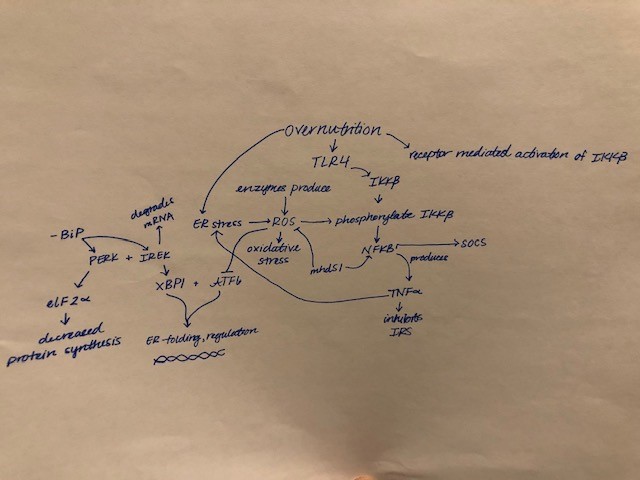Metabolic syndrome is the name for collective disorders caused by overnutrition. Some symptoms associated with metabolic syndrome include:
- Obesity
- Insulin resistance
- Impaired glucose tolerance
- Dyslipidemia
- High blood pressure
These symptoms on their own are predictors of development of more serious disorders such as type two diabetes and cardiovascular disease. New research suggests possible mechanisms for development of metabolic syndrome through brain inflammation, especially inflammation of the hypothalamus. Overnutrition activates an inflammatory pathway that alters signaling for leptin and insulin. Leptin and insulin are largely responsible for hunger cues and glucose tolerance. There are several different molecules and pathways impacted by overnutrition and leading to long term changes in the brain. These underlying mechanisms are not yet well understood, though the relationships are rather complex as shown by the image.
Prenatal impacts
When a mother has a high fat diet, consistent with the standard American diet, there can be long term impacts on the child. These changes are due to changes in the way the brain is “wired.” These changes occur when a mother breastfeeds her child and can lead to problems with a child’s eating and an endless cycle of obesity and metabolic syndrome.
Treatment
Treatment of obesity and metabolic disorders is complex and multi-faceted. Treatment possibilities have been explored in mice. The most promising treatment involves inhibition of NFKB/IKKB pathway. This can be accomplished through brain specific deletion of certain transcription factors. Thus far these treatments have only been applied in mice. More common treatments revolve around weight loss. Programs like Weight Watchers and Profile by Sanford are designed to help people navigate diet and nutrition to live healthier lifestyles. Treatment for obesity often requires a reframing of lifestyle choices as well as counseling to treat underling mental illness.
Culture
The United States is ranked #1 in obesity rates across the word at 36.2%. This statistic requires some questioning as other developed nations have much lower rates of obesity. Culture is likely one of the biggest causes of this ranking. According to the USDA, portion sizes are one important aspect to this ranking. In 2000, Americans ate an average of 20% more calories than in 1983. In addition, consumption of fats has increased approximately 45% since 1970. Overconsumption of saturated fats is an important risk factor for triggering inflammatory pathways that lead to metabolic syndrome. One of the most interesting aspects of culture differences is the impact it has on the way people eat in different areas. In the United States, we move fast. We eat fast, work fast, and aim to accomplish as much in the day as possible. In European countries, things move more slowly. People will sit down for hours over a meal while enjoying each other’s company. Government regulations on food in different countries are also vastly different. Countries in Europe often require higher standards and result in food with greater nutrition. Additives are common in food in the United States while they are often outlawed in other countries. Portion sizes are also significantly larger in the US than they are in other countries.
